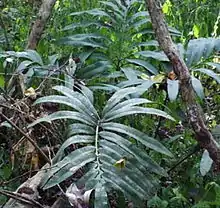Stangeriaceae
Stangeriaceae is the smallest family of the cycads, including only two extant genera, Stangeria and Bowenia.
| Stangeriaceae | |
|---|---|
 | |
| Stangeria eriopus in coastal lowland forest, South Africa | |
| Scientific classification | |
| Kingdom: | Plantae |
| Clade: | Tracheophytes |
| Division: | Cycadophyta |
| Class: | Cycadopsida |
| Order: | Cycadales |
| Suborder: | Zamiineae |
| Family: | Stangeriaceae Schimp. & Schenk |
| Genera | |
Taxonomy
Although the family was first published by Schimper and Schenk[1] as Stangerieae, the name Stangeriaceae was used by Johnson (who was unaware of previous uses) to include only the genus Stangeria.[2] Later, Stevenson expanded the family to include Bowenia.[3][4] This decision was based on some shared characters (synapomorphies) such as the presence of fused vacularized stipules, the lack or irregular production of cataphylls, and a few other anatomical and morphological traits.[4] Later molecular[5][6][7] evidence suggested that the two genera of the Stangeriaceae belonged in different positions within the Zamiaceae, thus leading other authors to propose dissolving the family.[8]
Genera
- Subfamily Stangerioideae
- Subfamily Bowenioideae
- Bowenia Hooker ex Hooker f. (2 species)
Distribution
The genus Stangeria occurs in South Africa, in the Kwa-Zulu Natal and Eastern Cape regions, while both species of Bowenia occur in Queensland, Australia.
| Wikispecies has information related to Stangeriaceae. |
References
- Metcalf Collection (North Carolina State University).; Schenk, August; Schimper, Wilhelm Philip; Scudder, Samuel Hubbard; Zittel, Karl Alfred von (1880). Handbuch der palaeontologie. Unter mitwirkung von W. Ph. Schimper; hrsg. von Karl A. Zittel. München: R. Oldenbourg. doi:10.5962/bhl.title.34265.
- Johnson, L A S; Johnson, L. A. S. (1959). "The families of cycads and the Zamiaceae of Australia". Proceedings of the Linnean Society of New South Wales. 84: 64–117.
- Stevenson, Dennis Wm. (1990-03-07). "Morphology and Systematics of the Cycadales". The Biology, Structure, and Systematics of the Cycadales: Proceedings of the Symposium CYCAD 87. The New York Botanical Garden Press: 8–55. doi:10.21135/893273507.003. ISBN 978-0-89327-350-7.
- Stevenson, Dennis WM. (1992-04-01). "A formal classification of the extant cycads". Brittonia. 44 (2): 220–223. doi:10.2307/2806837. ISSN 1938-436X. JSTOR 2806837. S2CID 41438950.
- Salas-Leiva, Dayana E.; Meerow, Alan W.; Calonje, Michael; Griffith, M. Patrick; Francisco-Ortega, Javier; Nakamura, Kyoko; Stevenson, Dennis W.; Lewis, Carl E.; Namoff, Sandra (2013-11-01). "Phylogeny of the cycads based on multiple single-copy nuclear genes: congruence of concatenated parsimony, likelihood and species tree inference methods". Annals of Botany. 112 (7): 1263–1278. doi:10.1093/aob/mct192. ISSN 0305-7364. PMC 3806525. PMID 23997230.
- Rai, Hardeep S.; O’Brien, Heath E.; Reeves, Patrick A.; Olmstead, Richard G.; Graham, Sean W. (2003-11-01). "Inference of higher-order relationships in the cycads from a large chloroplast data set". Molecular Phylogenetics and Evolution. 29 (2): 350–359. doi:10.1016/S1055-7903(03)00131-3. ISSN 1055-7903. PMID 13678689.
- Chaw, Shu-Miaw; Walters, Terrence W.; Chang, Chien-Chang; Hu, Shu-Hsuan; Chen, Shin-Hsiao (2005-10-01). "A phylogeny of cycads (Cycadales) inferred from chloroplast matK gene, trnK intron, and nuclear rDNA ITS region". Molecular Phylogenetics and Evolution. 37 (1): 214–234. doi:10.1016/j.ympev.2005.01.006. ISSN 1055-7903. PMID 16182153.
- Christenhusz, M. J. M.; Reveal, J. L.; Farjon, A.; Gardner, M. F.; Mill, R. R.; Chase, M. W. (2011-02-18). "A new classification and linear sequence of extant gymnosperms". Phytotaxa. 19 (1): 55. doi:10.11646/phytotaxa.19.1.3. ISSN 1179-3163.